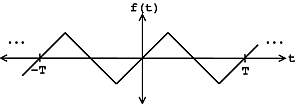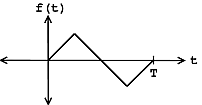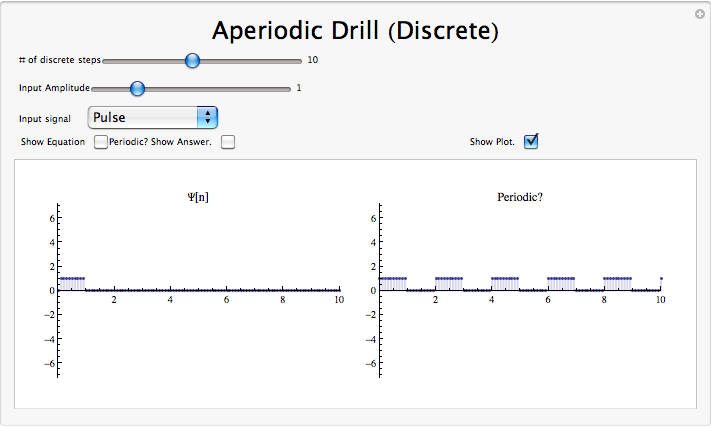9.1: Discrete Time Aperiodic Signals
- Page ID
- 22893
Introduction
This module describes the type of signals acted on by the Discrete Time Fourier Transform.
Relevant Spaces
The Discrete Time Fourier Transform maps arbitrary discrete time signals in \(l^2(\mathbb{Z})\) to finite-length, discrete-frequency signals in \(L^2([0,2 \pi))\).

Periodic and Aperiodic Signals
When a function repeats itself exactly after some given period, or cycle, we say it's periodic. A periodic function can be mathematically defined as:
\[f[n]=f[n+m N] \quad m \in \mathbb{Z} \label{9.1} \]
where \(N > 0\) represents the fundamental period of the signal, which is the smallest positive value of N for the signal to repeat. Because of this, you may also see a signal referred to as an N-periodic signal. Any function that satisfies this equation is said to be periodic with period N. Periodic signals in discrete time repeats themselves in each cycle. However, only integers are allowed as time variable in discrete time. We denote signals in such case as \(f[n]\), \(n = ..., -2, -1, 0, 1, 2, ...\) Here's an example of a discrete-time periodic signal with period N:
We can think of periodic functions (with period \(N\)) two different ways:
- as functions on all of \(\mathbb{R}\)

Figure \(\PageIndex{3}\): discrete time periodic function over all of \(\mathbb{R}\) where \(f[n_0]=f[n_0+N]\) - or, we can cut out all of the redundancy, and think of them as functions on an interval \([0,N]\) (or, more generally, \([a,a+N]\). If we know the signal is N-periodic then all the information of the signal is captured by the above interval.

Figure \(\PageIndex{4}\): Remove the redundancy of the period function so that \(f[n]\) is undefined outside \([0,N]\).
An aperiodic DT function, however, \(f[n]\) does not repeat for any \(N \in \mathbb{R}\); i.e. there exists no \(N\) such that Equation \ref{9.1} holds. This broader class of signals can only be acted upon by the DTFT.
Suppose we have such an aperiodic function \(f[n]\). We can construct a periodic extension of \(f[n]\) called \(f_{No}[n]\), where \(f[n]\) is repeated every \(N_0\) seconds. If we take the limit as \(N_{0} \rightarrow \infty\), we obtain a precise model of an aperiodic signal for which all rules that govern periodic signals can be applied, including Fourier Analysis (with an important modification). For more detail on this distinction, see the module on the Discete Time Fourier Transform.
Aperiodic Signal Demonstration

Conclusion
A discrete periodic signal is completely defined by its values in one period, such as the interval [0,N]. Any aperiodic signal can be defined as an infinite sum of periodic functions, a useful definition that makes it possible to use Fourier Analysis on it by assuming all frequencies are present in the signal.


